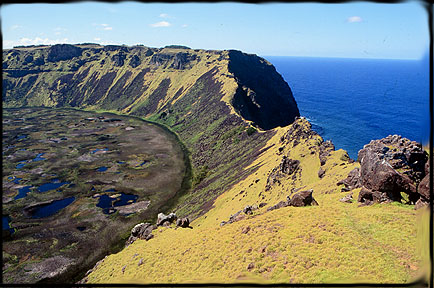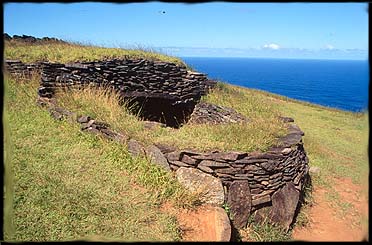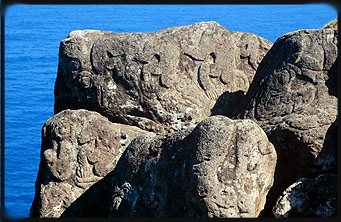
Above: The rim of Rano Kau became the center of the Easter Island Birdman Cult
High on the rim of the crater known as Rano Kau was the ceremonial village of Orongo. Built to worship the god of fertility - Makemake, it became the site of a grueling competition.

 One
of the most fascinating sights at Orongo are the hundreds of petroglyphs
carved with birdman and Makemake images. Carved into solid basalt, they
have resisted ages of harsh weather. It has been suggested that the images
represent birdman competition winners. Over 480 birdman petroglyphs have
been found on the island, mostly around Orongo.
One
of the most fascinating sights at Orongo are the hundreds of petroglyphs
carved with birdman and Makemake images. Carved into solid basalt, they
have resisted ages of harsh weather. It has been suggested that the images
represent birdman competition winners. Over 480 birdman petroglyphs have
been found on the island, mostly around Orongo.
As birdman images transformed the rocks so to were the islanders transformed. It seemed that the culture was beginning to rebuild itself. We will never know whether the Rapa Nui would have survived and prospered because in 1862 wave after wave of slave traders landed on Easter Island and took away all healthy individuals. In the space of one year, a level of injury, death and disease was inflicted on the population leaving a broken people, bereft of leadership. As their culture lay in disarray a new force entered the seen whose actions would forever deny the world of a true understanding of the Rapa Nui culture.
 The
missionaries arrived on Easter when the people were at their most vulnerable.
With their society in ruin it did not take long to convert the population
to Christianity. First to go was the islanders style of dress, or lack
of. Tattooing and use of body paint was banned. Destruction of Rapa Nui
artworks, buildings, and sacred objects, including most of the Rongo-rongo
tablets - the key to understanding their history - was swift and complete.
Islanders where forced off their ancestral lands and required to live in
one small section of the island while the rest of the land was used for
ranching.
The
missionaries arrived on Easter when the people were at their most vulnerable.
With their society in ruin it did not take long to convert the population
to Christianity. First to go was the islanders style of dress, or lack
of. Tattooing and use of body paint was banned. Destruction of Rapa Nui
artworks, buildings, and sacred objects, including most of the Rongo-rongo
tablets - the key to understanding their history - was swift and complete.
Islanders where forced off their ancestral lands and required to live in
one small section of the island while the rest of the land was used for
ranching.
Eventually all pure blood Rapa Nui died out. Annexation with Chile brought new influences and today there are only a few individuals left with ties to the original population.
All rights reserved. Unauthorized copying and manipulation is prohibited.